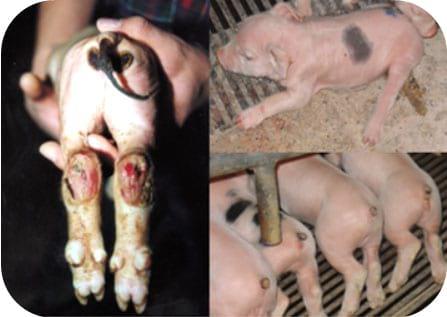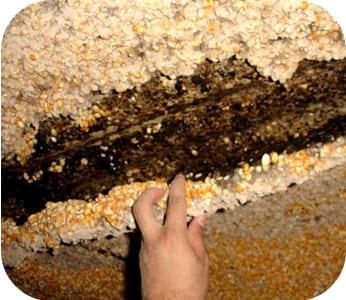mycotoxin risk management system
European experts see an increase in mycotoxin contamination globally - A mycotoxin risk management system can help

Abstract
Mycotoxin contamination of crops represents a widespread problem. Despite extensive efforts during crop growth, harvesting or storage, it is not possible to completely avoid mycotoxin contaminations in feed. Therefore successful counteracting strategies become increasingly important. Due to the fact that some mycotoxins cannot be adsorbed sufficiently only a combination of different strategies will work effectively.
According to an opinion poll published on All About Feed in August 2007, 58.2% of the participants think that the risk of mycotoxins in raw materials will globally become greater in the future. Due to global trade of agricultural commodities the discussion about the mycotoxin hazard has intensified.
It is important to understand the complexity of mycotoxins and the existing counteracting strategies against this threat.
Mycotoxins are secondary metabolites produced by several fungi under natural conditions. The contamination of feedstuffs with mycotoxins poses a serious threat to the health of humans and animals. Mycotoxicoses are diseases caused by mycotoxin ingestion, inhalation or skin-contact. The effects of mycotoxins in animals are diverse, varying from immune suppression to death in severe cases, depending on toxin-related (type of mycotoxin consumed, level and duration of intake), animal-related (animal species, sex, age, breed, general health and immune status) and environmental (farm management, hygiene, temperature) factors. 
Figure 1: Mycotoxicoses in piglets
Mycotoxins can accumulate in maturing corn, wheat, soybeans, sorghum, peanuts and other food and feed crops on the field, during transportation or during storage. The occurrence of mycotoxins in food and animal feed often shows a geographical pattern, as for example Aspergillus species meet optimal conditions in tropical and subtropical regions, whereas Fusarium and Penicillium species are adapted to the moderate climate of North America and Europe.
However, worldwide trade of food and feed commodities has resulted in a worldwide distribution of contaminated materials. Additionally, each plant can be affected by more than one fungus and each of them can produce more than one mycotoxin. Consequently, there is a great probability that many mycotoxins are present in one feed, thus increasing the odds of interactions between mycotoxins and the occurrence of synergistic effects, which are of great concern in livestock health and productivity.
The exact figures of economic losses due to mycotoxin – contamination cannot be accurately evaluated. Economic impacts are felt by crop- and animal producers as sampling- and analytic costs as well as decreased profits caused by reduced animal performance.
Figure 2: Fungi contaminated feed
Which strategies work efficiently against mycotoxins?
Although extensive efforts on preventive actions during crop growth, harvesting and storage are taken, there exists a potential risk of mycotoxin contamination thus successful detoxification procedures after harvest become increasingly important. The detoxification procedures are divided into three categories: physical, chemical and biological methods.
Physical and chemical methods
There are several physical methods to decrease the mycotoxin contamination in the feed. Among them mechanical sorting, washing, density segregation, irradiation or thermal inactivation are the most commonly used. However, the efficacy of physical treatments depends on the level of contamination and the distribution of mycotoxins through the grain.
Additionally the results obtained are often uncertain and associated with high losses. Various chemicals (bases, oxidizing agents, different gases …) have been tested for detoxification of mycotoxins but only a limited number of them have shown to be effective against mycotoxins without reducing nutritive value, palatability of the feed or producing toxic by-products. For achieving adequate decontamination results several parameters like reaction time, temperature and moisture have to be monitored. Due to their uncertain and uneconomic results, the practical application of physical and chemical treatments is very limited.
Biological methods
The use of adsorbent materials is a very common method to prevent mycotoxicoses especially aflatoxicosis. These compounds added to the feed bind the toxin during the digestive process in the gastrointestinal tract resulting in a reduction of toxin bioavailability.
The adsorption of mycotoxins requires molecule polarity and also a suitable position of the functional groups. Due to this fact only a few mycotoxins can be adsorbed efficiently without affecting essential feed ingredients.
Biological detoxification of mycotoxins by microorganisms and/or enzymes has been researched for over thirty years. This method is based on deactivation of mycotoxins directly in the gastrointestinal tract and offers a very specific, irreversible, efficient way of detoxification. Binder et al. isolated a pure bacterial strain, which was able to biotransform the epoxide group of trichothecenes. The 12,13-epoxide ring is mainly responsible for their toxicity. This detoxifying strain Eubacterium BBSH 797 was the first microbe used in a mycotoxin deactivating feed additive.
Further a novel yeast strain, capable of degrading ochratoxin A (OTA) and zearalenone (ZON) was isolated and characterized by Schatzmayr et al. The strain named Trichosporonmycotoxinivorans (MTV) detoxifies OTA by cleavage of the phenylalanine moiety from the isocumarin derivate ochratoxin α. Consequently, less or non adsorbable mycotoxins have to be treated by enzymatic deactivation and only a combination of different strategies will lead to success.

Dear DI Karin Griessler,
The figure 1. is not caused by mycotoxin.
Regards,
Biro, Hunor DVM
swine specialist
Hon.Assoc. Professor
Kaposvar - Hungary








.jpg&w=3840&q=75)